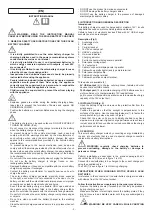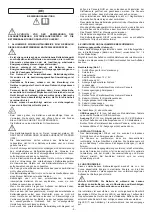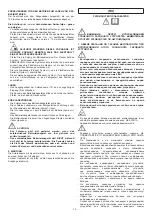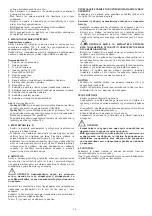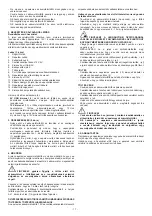
- 3 -
(EN)
INSTRUCTION MANUAL
WARNING: READ THE INSTRUCTION MANUAL
CAREFULLY BEFORE USING THE SOLAR BATTERY CHARGER!
1. GENERAL SAFETY USER INSTRUCTIONS FOR THIS SOLAR
BATTERY CHARGER
- It is strictly prohibited to use the solar battery charger for
charging batteries used in the power accumulation systems
connected to the mains or on islands!
- It is strictly prohibited to use it on downstream batteries to
which energy conversion systems with outputs of over 48V
are connected!
- It is strictly prohibited to use the solar battery charger for uses
other than those it was designed for.
- Inexperienced and untrained personnel should be properly
instructed before using the appliance.
- People (children included) whose physical, sensory or mental
capacities would prevent them from using the appliance
correctly must be supervised by a person who is responsible
for their safety while the appliance is in use.
- Children must be supervised to prevent them from playing
with the appliance.
- Explosive gases are emitted during the battery charging phase;
take steps to prevent the formation of flames and sparks. NO
SMOKING ALLOWED.
- Position the batteries in a well-ventilated area during the charging
phase.
- The battery charger can be used outdoors: DO NOT EXPOSE IT
TO RAIN OR SNOW (IPx4).
- Do not connect or disconnect the charge terminals to the battery
when the battery charger is working.
- To prevent damage to the vehicle electronics, read, keep and
comply with all the warnings provided by the manufacturers of
such vehicles, when using the solar battery charger; the same
applies to the recommendations provided by the vehicle battery
manufacturer.
- To prevent damage to the device electronics, read, keep and
comply with all the warnings provided by the manufacturers of such
devices, when using the solar battery charger; the same applies to
the recommendations provided by the manufacturer of the battery
to be charged.
- Do not invert the connection polarity when charging the batteries.
- Do not use the battery charger to charge frozen or non-
rechargeable batteries.
- Damaged batteries or those non-compatible with the solar battery
charger may explode if recharged.
- Contact the battery manufacturer for specific queries on how to
charge the same.
- The solar battery charger generates electricity when exposed
to the light, even when it is not connected to a device or to the
battery: contact with the output terminals, improper use or improper
connections can lead to electric shocks and burns.
- Even if the solar battery charger is flexible, ONLY open and close
the panels using the natural folds in the battery charger fabric
parts. Do not close the panels with the solar cells facing outwards.
- Do not fold or crease the solar battery charger using sharp edges
or objects.
- Do not dry clean or wash the battery charger in the washing
machine.
- Close the battery charger panels and store in a dry place when not
in use.
- DO NOT use the product in marine environments.
- DO NOT damage the battery charger cables.
- DO NOT use the battery charger in the presence of damaged
electrical parts and/or cables.
2. INTRODUCTION AND GENERAL DESCRIPTION
Intended use
This battery charger is used to charge and/or maintain 12V / 6 cells
lead batteries used on motor vehicles (petrol and diesel).
Cellular phones or electronic devices fitted with 5V USB charger
sockets can also be recharged.
Description (Fig.1)
1. Anchorage slots.
2. Solar cells.
3. Carry-all pocket.
4. 12V, 5V socket panel.
5. USB 5V output port.
6. On-mode indicator.
7. Charging indicator.
8. Port to connect multiple panels in parallel.
9. Solar panel voltage input.
10. 12V output port.
11. Cable to connect multiple panels in parallel.
12. Cable with cigarette lighter jack type male terminal.
13. Solar panel output cable.
14. Cable with charge terminal.
15. Cable with polarized output terminal.
Three ports are available (4):
-
5V USB output
(5) to charge cellular phones, tablets and other
devices that use USB sockets.
-
12V output port
(10) to maintain charging of 12V batteries used on
motor vehicles or to charge/maintain 12V lead batteries.
- port to connect other panels in parallel so as to increase the charge
capacity of the 12V output port.
3. INSTALLATION (Fig. 2)
- Open the battery charger and remove the protective film from the
solar panels.
- Position the panels so that the sunlight is perpendicular to the
surfaces of the same. Use the supplied fasteners (1) to fasten the
solar panels firmly in place, as seen in Figure 1.
- Check that the solar cells are not partially shaded to achieve
maximum output power. Highest charge performance is achieved
in clear sky and full sun conditions; in cloudy conditions the charge
performance will be lower.
4. OPERATION
This solar battery charger works by converting energy irradiated by
the sun into electricity that is used via special charge connection
cables with no battery interruptions.
WARNING: regularly check charging batteries to
prevent overloading, damage to the battery or damage to
persons or things.
Perform installation as described in the previous paragraph and
check that the LED (6) seen in figure 1 is ON.
Connect the device/battery to be charged to the correct charge port
using the supplied cable.
The LED (7) seen in figure 1 is ON during charging.
PRECAUTIONS WHEN CHARGING MOTOR VEHICLE LEAD
BATTERIES
In reference to the connection of the solar battery charger via cables
with clamps from the 12V output socket.
Follow the instructions scrupulously in the order given below.
- Remove the battery covers (if present), so that the gas produced
during charging can exit.
- Make sure the level of electrolyte covers the battery plates; if they
are not covered, add distilled water until they are submerged by
5-10 mm.
WARNING! BE VERY CAREFUL WHILE CARRYING



